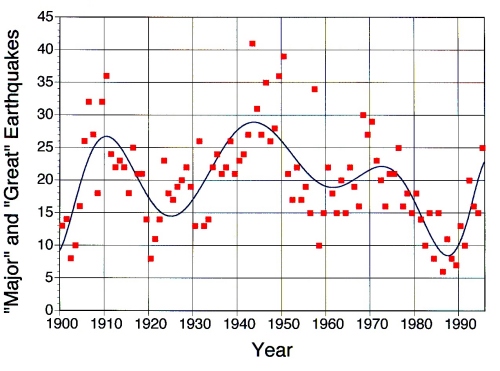An Urban Legend
As the Twentieth Century comes to an end and a new millennium approaches, many would-be prophets predict increasing natural disasters. This concern about earthquakes, volcanoes, famine, and epidemic disease is not without reason. More people have died in the Twentieth Century because of earthquakes, for example, than from war. Both secular and religious seers regard earthquakes to be a sign that civilization faces an impending cataclysm. In his book, A.D. 2000: A Book About the End of Time, Rene Noorbergen, a secular author on the occult, predicts:
Earthquakes and volcanic eruptions will occur with increasing frequency; in fact, a higher increase of these events will shake us to the core and will make our survival a constant struggle from now on.1
Noorbergen bases his prediction on the past:
The world has already been shocked by the renewed volcanic eruptions and the increased seismic activity foretold by French visionary Nostradamus.2
Sometimes Bible teachers rephrase the notion that earthquakes are on the increase:
In this century, there have been more earthquakes than all the rest of history put together.... Every 10 years, earthquakes double in number, and so it has been for the last 10 decades. During the later part of this decade, earthquakes will occur with increasing regularity, creating terror and panic throughout the world. Jesus said that was one of the signs of His coming.3
Gary Stearman, a writer on Bible prophecy, used data published in the October 11, 1995, Philadelphia Inquirer. According to that newspaper the number of Richter magnitude 6.0 and greater earthquakes worldwide has been increasing from nine in the 1950s, to 13 in the 1960s, to 51 in the 1970s, to 86 in the 1980s, and to more than 100 in the 1990s. Stearman4 used this data to argue for a pronounced increase in the frequency of the largest earthquakes. When Stearman's readers confronted him with much more earthquake data than in the Philadelphia Inquirer, he was compelled to revise significantly these numbers.5 However, Stearman still insists that earthquakes are increasing.
Do we have here an example of an urban legend? How well-documented are recent statements concerning earthquakes being on the increase? Are the data sets for this century's earthquakes complete? Have the deployment of more seismographs during the last few decades made detection and cataloging of earthquakes more complete, thereby enhancing the perception of increase? Does the public have the perception that earthquakes are on the increase because earthquakes now afflict our larger urbanized populations, and, therefore, are more often reported by the media?
Catalogs of Earthquakes
The year 1997 marked the one hundredth anniversary of the general deployment of standardized and calibrated seismographs. As a result, continuous global monitoring of large earthquakes has now continued for more than 100 years.6 Global, historic earthquake data have been synthesized and are available from three main sources:
- National Earthquake Information Center (NEIC) of the United States Geological Survey (USGS). The NEIC maintains an Internet web site with databases and summary files open to the public (the URL is http://earthquake.usgs.gov).
- Council of the National Seismic System (CNSS), a consortium of thirty seismological institutions. Each of the member organizations submits data to an authoritative composite catalog that interested researchers can investigate on the Internet (the URL is http://quake.geo.berkeley.edu:80/cnss).
- National Geophysical Data Center (NGDC) of the National Oceanographic and Atmospheric Administration (NOAA). The NGDC has produced a two-volume CD-ROM called the "Seismicity Catalog" detailing over four million seismic events from 2100 B.C. to 1995 A.D.7 A major part of the catalog is on the Internet and will be updated frequently.
Care and good judgment must be exercised in using global seismic data. Many events smaller than magnitude 6.5 were not reported or properly measured for the early part of the century. Therefore, we cannot compare effectively the frequency of events less than 6.5 from the first and second halves of the century. The global synthesis of magnitude 7.0 and greater is good, even for the earlier decades of the century. However, some catalogs which might be assumed to provide complete records, actually have noteworthy deficiencies. For example, checking the composite global database of the CNSS against CNSS member organizations, revealed many omissions from the main catalog of known earthquakes, even many earthquakes greater than magnitude 7.0 in the 1990s. Careful study must be conducted before a trustworthy earthquake inventory can be made.8
Global Synthesis of Twentieth-Century Earthquakes
Excellent global summaries of the frequency of large earthquakes have been prepared by the NEIC (for example see the Internet web site at http://wwwneic.cr.usgs.gov/neis/eqlists/
 |
The global earthquake frequency data can be used to argue just the opposite of the popular urban legend; earthquake frequency through the century appears to indicate overall a slight decrease. For the data in figure 1 we note 1,093 big earthquakes for the first half of the century (1900 to 1949). That is an average of 22 big earthquakes per year. For the nearly completed second half of the century (1950 to 1996) we note just 850 big earthquakes. That is an average of just 18 per year. When 1998 and 1999 are completed, it is likely that the second half of the century will have about 900 big earthquakes—nearly 200 less than the first half. Thus, the 30-year cyclic pattern appears to be modulated around a slightly-declining trend. This earthquake frequency pattern is consistent with creationist ideas suggesting overall exponentially-declining tectonism and volcanism following Noah's Flood.9
Twentieth-Century Earthquakes As "Birth Pangs"
The Lord Jesus Christ spoke of earthquakes as "signs" of His coming again to receive His saints. He said, "There will be earthquakes in divers places" (Matthew 24:7; Mark 13:8), a fact now verified by the global distribution of earthquakes recorded on seismographs. Most noteworthy is Jesus' statement that the earthquake sign is the "beginning of sorrows" (Matthew 24:8; Mark 13:8). The word translated sorrows in many English Bibles is the Greek word for "birth pangs." Just as we know from birth pangs that a pregnant woman is about to give birth to a child, Jesus says we know that the intolerable anguish of God's judgment and the return of His Son is at hand. The 30-year cyclic curve of earthquake frequency in figure 1 is consistent with Jesus' statement about birth pangs.10
The apostle Paul also develops the birth pang theme when he notes that the whole creation is "groaning in travail" (Romans 8:22) awaiting the new birth of the world. The apostle John speaks of a "great earthquake" associated with the opening of the sixth seal (Revelation 6:12), followed by the sign of the pregnant woman (Revelation 12:2), and followed by the greatest earthquake since men have been upon the earth (Revelation 16:18-20). This future "Armageddon earthquake" will be associated with the return of Christ to Jerusalem (Acts 1:9-11; Zechariah 14:1-11) and is described as inflicting severe topographic and geologic changes on a global scale.11 After God's voice shakes the earth mightily (Hebrews 12:26) and fully accomplishes these extraordinary geologic changes, His saints will receive a "kingdom which cannot be moved" (Hebrews 12:27-29).
References
1 Rene Noorbergen, A.D. 2000: A Book About the End of Time (New York, Bobbs-Merrill Co., 1984), p. 80.
2 Ibid. The statement comes from inside the front of the book's dust jacket.
3 Lester Sumrall, "Famines, Pestilence, Earthquakes, as Man Rebels," in Bob Anderson et al., Earth's Final Days (Green Forest, AR, New Leaf Press, 1994), pp. 63-76.
4 Gary Stearman, "Are Earthquakes on the Increase?" Prophecy in the News (June 1996).
5 See Stearman's apology for the Philadelphia Inquirer's incomplete data in "Earthquakes are Indeed on the Increase" (pp. 27-28) in the next issue of Prophecy in the News.
6 K. Abe and S. Noguchi, "Revision of magnitudes of large shallow earthquakes, 1897-1912," Physics of Earth and Planetary Interiors, 33 (1983), pp. 1-11.
7 National Oceanographic & Atmospheric Administration, Seismicity Catalog (Boulder, CO, National Geophysical Data Center, 1996), two volumes on CD-ROM.
8 For an updated introduction to the various earthquake information sources see Dr. Steve Malone's "Surfing the Internet for Earthquake Data" (the URL is http://www.geophys.washington.edu/seismosurfing.html).
9 Steven A. Austin, John R. Baumgardner, D. Russell Humphreys, Andrew A. Snelling, Larry Vardiman, and Kurt P. Wise, Catastrophic Plate Tectonics: A Global Flood Model for Earth History (Santee, CA., Geology Education Materials, 1996), 48 pp. and 80 slide photographs.
10 Steven A. Austin, "Earthquakes in these Last Days," Institute for Creation Research Impact No. 198 (December 1989), 4 pp.
11 Henry M. Morris, The Revelation Record (Wheaton: Tyndale House Publishers, 1983), p. 321.
*Dr. Austin is Chairman of the Geology Department at ICR.
















